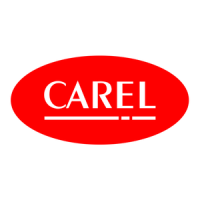
Do you have a question about the Carel uRack and is the answer not in the manual?
| Brand | Carel |
|---|---|
| Model | uRack |
| Category | Control Unit |
| Language | English |
Covers general safety, handling, environmental, and operational precautions for CAREL products.
Provides guidance on the correct disposal of waste electrical and electronic equipment (WEEE).
Alerts users to separate power and signal cables to avoid electromagnetic interference.
Details the overall operational capabilities and features of the µRack controller.
Outlines the core functions, controlled devices, programming methods, and hardware features.
Explains the function of buttons, status LEDs, and display icons on the µRack interface.
Describes the meaning and function of LED indicators and display icons for unit status and alarms.
Guides the initial power-up and default parameter loading process for new unit installations.
Details how to set up the unit, including circuit type, compressor/fan allocation, and relay functions.
Explains the purpose and connectivity of the unit's analogue and digital inputs and outputs.
Covers basic parameters for compressor ON/OFF control, including number, times, and type.
Explains different rotation types (LIFO, FIFO, Time) to balance compressor operating hours.
Details control methods like proportional band and dead band for managing compressor operation.
Specifies the number of compressors forced ON during a suction probe fault condition.
Describes how to manage and control compressors that have varying capacity ratings.
Explains how to temporarily disable compressors for maintenance purposes.
Details the management of compressor racks with Medium Temperature (MT) and Low Temperature (LT) circuits.
Covers parameters for minimum ON/OFF times and between-start/stop delays for compressors.
Outlines how fan operation is managed based on discharge pressure and includes fan rotation.
Explains the dead band control mechanism for fan activation and deactivation.
Details settings for fan inverter control, including speed-up time and minimum opening.
Describes the generation and use of PWM signals for fan speed control via specific modules.
Explains the floating condenser control function and its associated parameters.
Allows manual activation of devices, overriding normal control functions for specific tasks.
Explains how to monitor compressor operating hours and set maintenance alarms.
Describes how a digital input can be used to adjust the set point, e.g., for night-time operation.
Allows selection of the refrigerant type for accurate pressure-to-temperature conversion.
Details the configuration and use of auxiliary temperature probes for enhanced monitoring.
Describes the function to prevent unit shutdown by gradually decreasing capacity under high discharge pressure.
Explains alarms that automatically reset when the fault condition is resolved.
Details alarms that require manual intervention via the Reset Alarms parameter to clear.
Describes low-pressure alarms that initially auto-reset but require manual reset after multiple occurrences.
Explains the configuration and function of the alarm relay output.
Lists alarms triggered by analogue inputs, including pressure and temperature thresholds.
Details the available serial interface boards for connecting to supervisory systems.
Covers the CAREL communication protocol and necessary parameter settings for supervisor connection.
Explains the different user, installer, and manufacturer parameter access levels and password protection.
Provides a comprehensive list of all configurable parameters, their types, ranges, and default values.